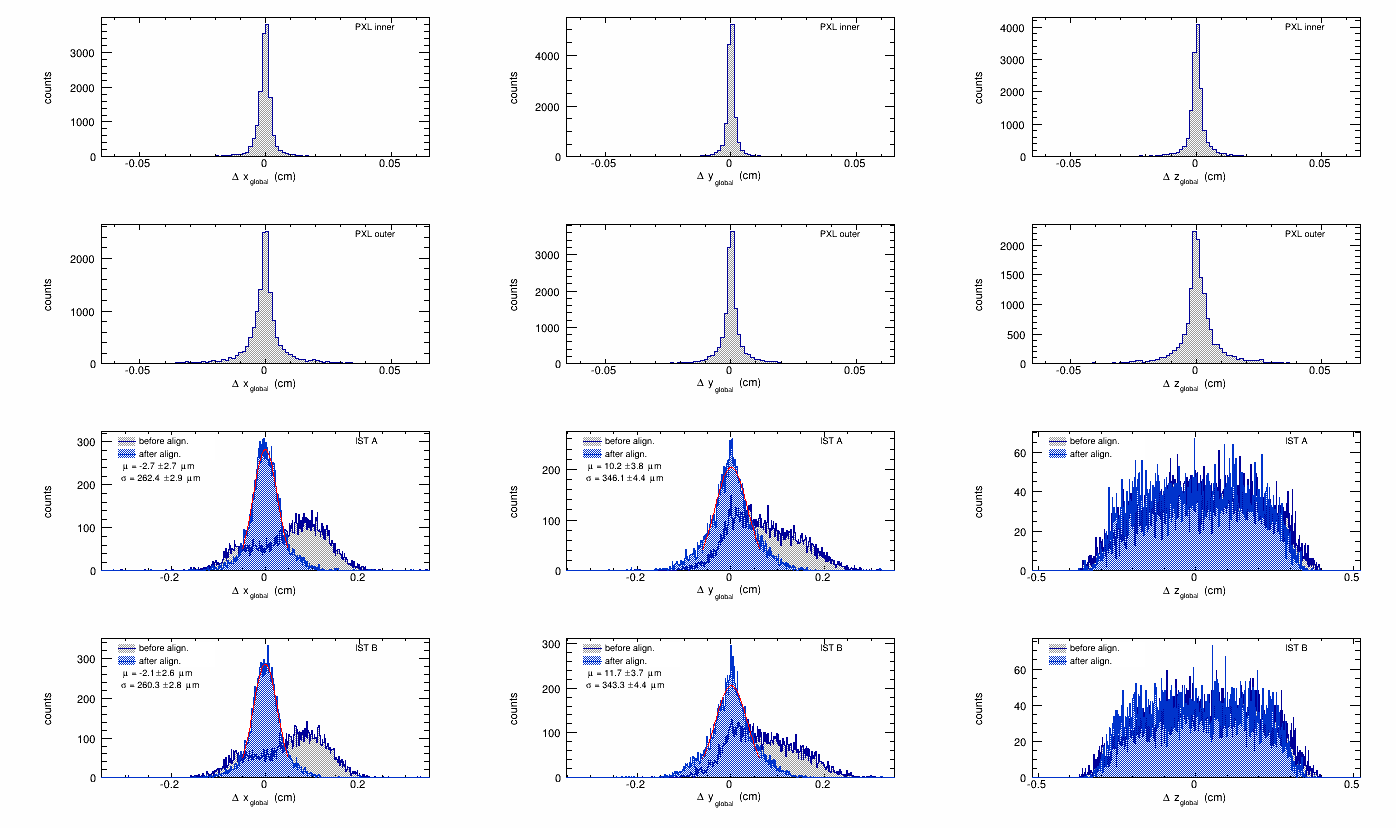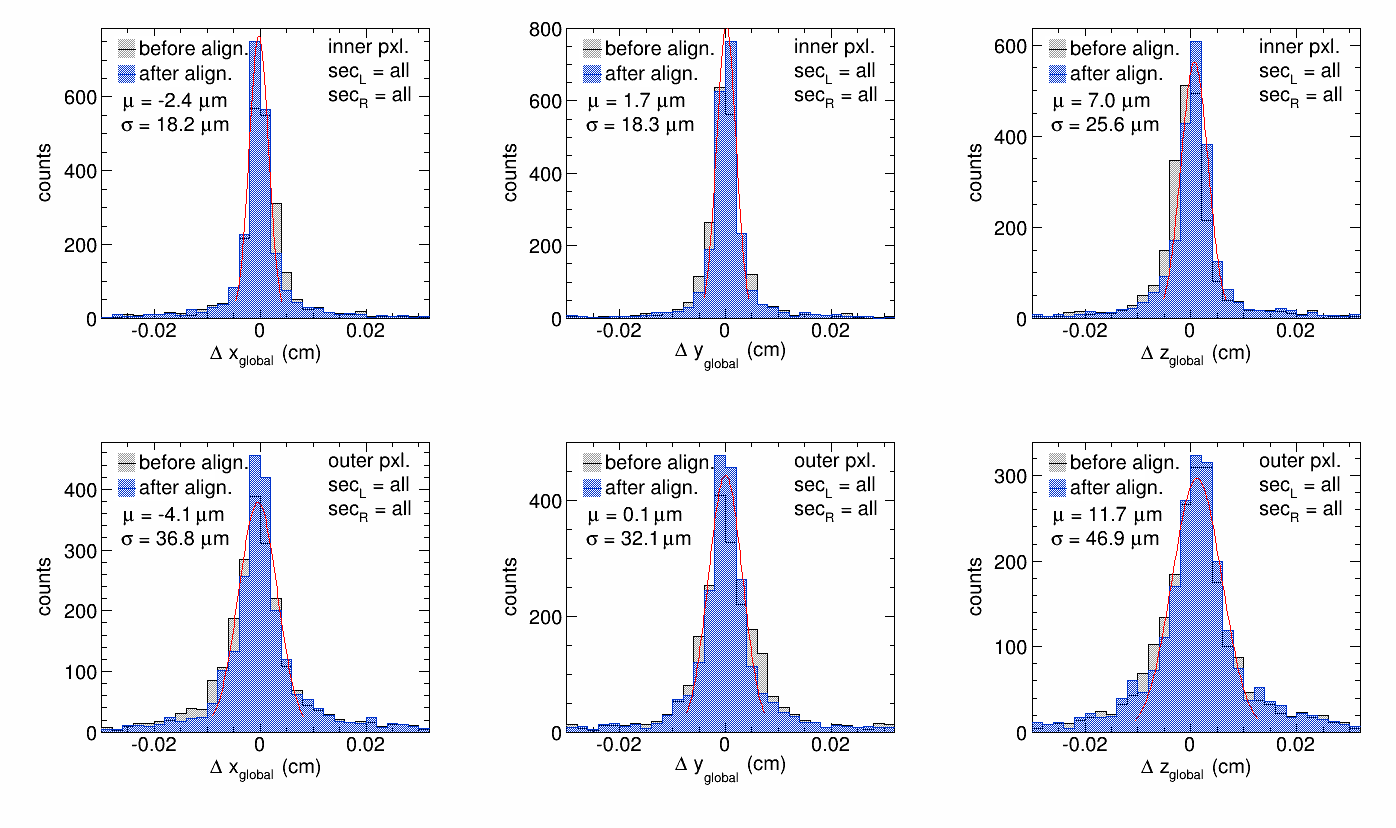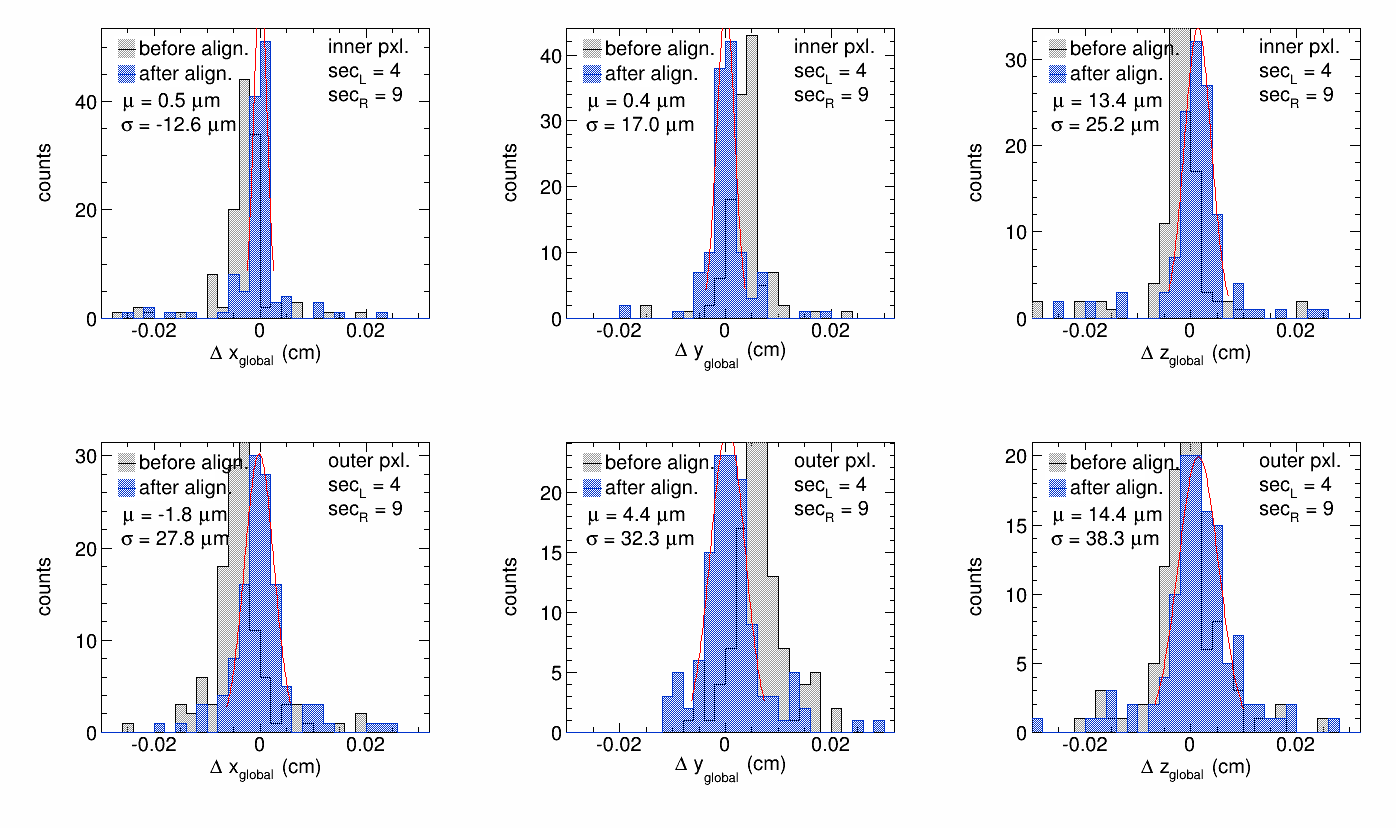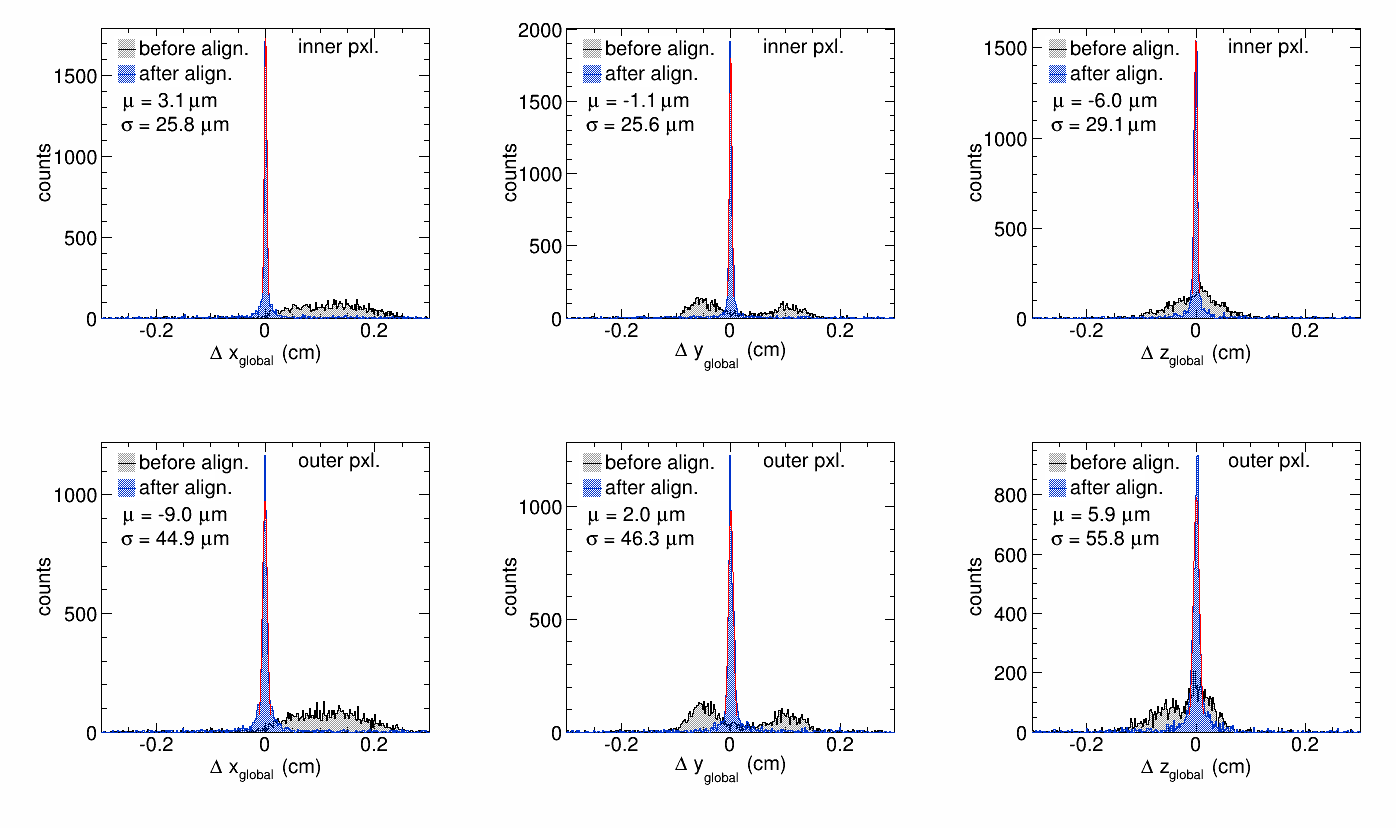HFT Alignement in Run14
This is the page reporting progresses on the HFT detector alignment in RHIC run 2014
Apr. 21, 2014 - Xin Dong
Progress report on the alignment with the low luminosity data.
Mar. 23, 2014 - Alexander Schmah
I did a first global HFT (PXL+IST) to TPC alignment using cosmic data with magnet on (files produced by Xin). A cut on the momentum of p > 5 GeV/c was applied. Similar requirements for the residuals and background rejection as for the magnet off data were used. The HFT alignment parameters are relatively small. Please find below the global PXL+IST alignment parameters (on top of all previous parameters) and the residuals before and after alignment.
------------------------------------------------
rotation matrix scheme
| x' | | xx xy xz | | x |
| y' | = | yx yy yz | | y |
| z' | | zx zy zz | | z |
|1 0.000354996 -1.34822e-05|
|-0.00035497 0.999998 0.0018345|
|1.41334e-05 -0.00183449 0.999998|
shift vector = {-0.0419401, 0.0192231, 0.208379}
------------------------------------------------
.gif)
Mar. 14, 2014 - Alexander Schmah
I did a ladder-by-ladder alignment for the IST but was not able to significantly improve the result from the global IST alignment. I sggest do leave the IST alignment as it is until we get Au+Au no mangetic field data to improve it. Below are 2D residuals for the IST for all 24 ladders from the global IST to PXL alignment. The Delta z-residuals are not shown (centered but very wide distributions).
![]()
Mar. 10, 2014 - Alexander Schmah
I did a first global IST alignment based on the previous sector-to-sector PXL alignment. Again no-magnetic field cosmics were used with 4 PXL hits. Below are the global residuals for PXL and IST. A and B are two IST residuals for two different PXL tracklets of the same track. I will check next the residuals vs. z and the sector-to-sector residuals. The alignment parameters are listed below:
------------------------------------------------
rotation matrix scheme
| x' | | xx xy xz | | x |
| y' | = | yx yy yz | | y |
| z' | | zx zy zz | | z |
|0.999998 0.000378809 -0.00186552|
|-0.000384755 0.999995 -0.00318785|
|0.0018643 0.00318856 0.999993|
shift vector = {-0.0620382, -0.190289, -0.0363773}
------------------------------------------------

Mar. 06, 2014 - Alexander Schmah
I have included now all possible sector combinations for the sector-to-sector alignmen as suggested by Xin. Sector 1 is the reference. The procedure is similar as described before but I use now not only left/right half combinations. After every step the new aligned sector is added to the new reference list and used for the alignment of the next sector. Here is the order of sectors: 5,6,7,2,10,3,8,4,9. Below are a few redisual examples. All residual distributions are in the attachment section (bottom of this page). The file "STS_align.txt" contains the alignment parameters for all sectors in addition to my previous alignment.![]()
![]()
Feb. 22, 2014 - Alexander Schmah
I have modified my code and implemented a basic version of a sector-to-sector alignment using no magnetic field cosmics. The strategy is the following. One sector is a reference (sector 1), sec 6 aligned to 1, sec 7 aligned to 1, sec 2 aligned to 7,... here are the steps in detail:
step reference sector align sector
1. 1 6
2. 1 7
3. 7 2
4. 7 3
5. 3 9
6. 9 4
7. 4 10
8. 4 8
9. 10 5
Every sector has only overlap with two sectors from the other half. After that procedure all sectors are aligned to the original reference sectors. This procudure is of course not optimal (too many indirect refrences) but it is a starting point. The following two figures show the results relative to the previous alignment. The first figure is for all sectors combined, the second shows the combination 4-9, which showed a significant double peak structure in Xin's QA plots. One can see that the mean values and the widths have improved. The offsets for 4-9 are in principal gone.


Feb. 20, 2014 - Xin Dong
After applying the relative alignment obtained by Alex, please see the local residual distributions for all sector combinations here
local x - du
local z - dv
The figures show the residual distributions between any PXL hit relative to the straight line projection from any two other same-sector hits (from two layers). In each panel labeled as "Sec i-j" means the straight track from two hits in sector i and is projected to sector j and make the residual with the measured hit on sector j. So "Sec 1-6" would be the straight track from sec 1 projected to sec 6. "Sec 1-1" shows the residual of the tracks passing through the overlapping ladders in this sec and "Sec 1-10" shows the residual of the tracks passing through overlapping ladders in sec 1 and 10.
Additions:
Separated in inner/outer layers
local x - du - Inner
local z - dv - Inner
local x - du - Outer
local z - dv - Outer
Also after requiring the opposited projection should have two matched hits in two layers
local x - du - Inner
local z - dv - Inner
local x - du - Outer
local z - dv - Outer
Feb. 20, 2014 - Hao Qiu
The pxlSectorOnHalf from survey and pxlHalfonPxl from survey + Alex's first alignment result were put into the db.
Feb. 19, 2014 - Alexander Schmah
------------------------------------------------
rotation matrix scheme
| x' | = | xx xy xz | | x |
| y' | = | yx yy yz | | y |
| z' | = | zx zy zz | | z |
M =
|0.999988 -0.00049038 -0.00482335|
|0.000485125 0.999999 -0.00109049|
|0.00482388 0.00108814 0.999988|
shift_vector = {-0.199987, -0.0586518, -0.00557364} in cm
------------------------------------------------
The above transformation (M*p_vec + shift_vector) is applied to all
hits points for sensor ids 201-400 on top of Hao's survey results.
Feb. 19, 2014 - Alexander Schmah
New PXL half-to-half alignment done with zero magnetic field cosmics. The slopes in the delta XYZ vs. z distributions are gone after several itterations of the minimization procedure (see presentation). Resolutions for all residuals in the order of 30 mum.

Feb. 16, 2014 - Alexander Schmah (uploaded by Xin)
Alex did a quick half-to-half alignment based on the zero field cosmic data produced here
/star/u/dongx/lbl/hft/Run14/Cosmic_Data_FullSurvey/output/
After removing all the noisy channels, using the TPC tracks to clean up a bit further Alex was able to get a relatively clean signal.
Attached is a figure showing the 3D residual between a straight line defined by the inner/outer pixel hits of the left half to the inner pixel hit of the right half.

Brief comment on the expected resolution. - Xin Dong
Some quick estimate on the anglular smearing due to MCS. The thickness of PXL is ~ 0.5% X0 per layer and for beam pipe is 0.24% X0 per layer. Assuming 3 GeV muon tracks going top to bottom and always perpendicular to the ladder plane, the MCS contribution to the local residual in one direction is: (PXL1 at r=2.7cm, PXL2 at r=8cm)
Then if we take the intrisic single hit resolution of 12 um, using the straight line from hits in one sector from PXL1 and PXL2 and doing the projection to the opposite sectors, the projection position uncertainties from simple telescope estimation will be
third hit PXL layer 1 (opposite sector), 27 um
fourth hit PXL layer 2 (opposite sector), 44 um
Thus the expected resolution (in one direction local x or z) in the oppisite sector including the measured hit resolution (12 um) is
PXL layer 1: 19(+)27(+)12 = 35 um
PXL layer 2: 48(+)44(+)12 = 66 um
----
Feb. 16, 2014 - Xin Dong and Hao Qiu
The survey tables above the sector level have been calculated by Hao. Now they are located here
The production for zero-field cosmic data in Xin's directory so far are all produced with the survey tables only up to the sector level. Users can easily include new StarDb/Geometry/pxl in his analysis chain for his own analysis.
The output beased on Xin's HftMatchTree (different from the original one) were reprocessed with the full survey tables which are stored here
/star/u/dongx/lbl/hft/Run14/Cosmic_Data_FullSurvey/output/
----
Feb. 11, 2014 - Xin Dong
I started the offline production for the zero field cosmic day taken from day 037-040. Please check the details in the following directory
The output will be stored in the output/ directory. Both *event.root, *MuDst.root and analysis tree output based on my HftMatchTree.
- dongx's blog
- Login or register to post comments
